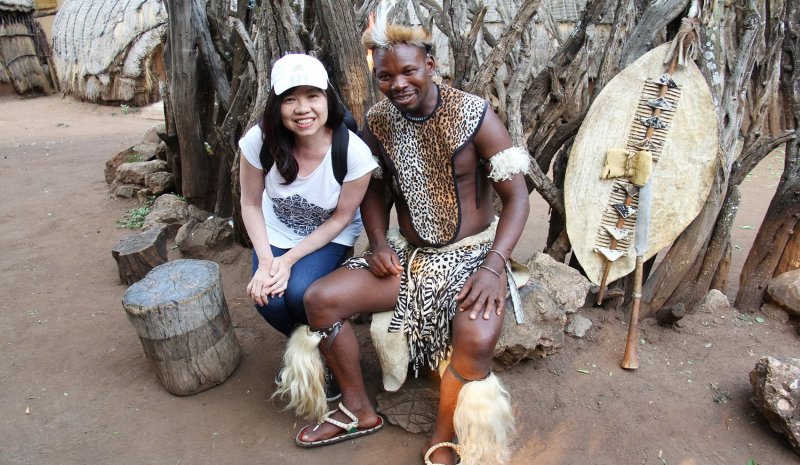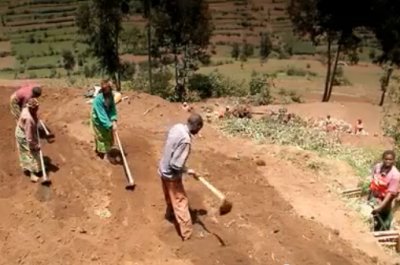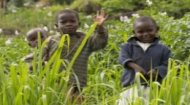-

Make a real difference...
-

to communities across Africa.
-

Share skills and knowledge...
-

and sponsor children...
-

to develop a better future
-

...and change lives forever!

Life in Rwanda changed for most of its citizens after the genocide
of 1994 which saw a tenth of its population killed including
300,000 of its children. Those scars still run deep, however the
country now looks to the future and there is much work to do for
living standards in Rwanda are still below those of sub-Saharan
Africa. Rwanda's population
mainly live in rural communities with those eight and a half
million living in homes made of woven branches and grasses,
covered with clay with hard red dirt floors, fabric where doors
and windows might be, no running water, no electricity and
normally a sheet tin roof. Many families also share their home
with the family chickens.
They
rely on farming to survive and Rwanda, slightly
larger than Wales, is often called "The Land of One Thousand
Hills" which gives a clue to the difficulties of farming
there, with some smallholdings at 55% inclinations to maximise
the use of land in a country with one of the highest population
densities in all of Africa. Such is the
scarcity of arable land that most family farms are around one
half hectare in size, too small for full scale commercial
production, yet lending themselves to the production of coffee
and tea. (Coffee being one of Rwanda's main industries with
500,000 coffee farmers located mainly along Lake Kivu and in
the central high plateau, each with a small family farm of
200-300 trees normally grown on terraces.)
Life in Rwanda: Child Sponsor Rwanda
Farming in Rwanda is the backbone of its small economy with
about 80% dependent on the land for their living although as
farms are split as they are handed down through the generations,
farming is becoming increasingly fragmented there. The government
has responded by educating farmers about best practices,
consolidating land so that farmers can synchronise their crop
production, sew improved quality seeds and use more fertiliser
to maximise crop output from what land is available. These
improvements have seen a doubling of bean production and a
tripling of maize, wheat and cassava production over the last
five years.

Many
Rwandans have constructed wooden bikes to help transport the
coffee cherries to a washing station however logistics pose a
problem with the countryside being unsuitable for vehicles for
transportation with what are deemed as roads resembling more
like goat trails. Landslides often destroy passable routes and
washed away bridges make what could be a lucrative farming
opportunity subsistence living with 65% of all rural Rwandans
living on or below the poverty line. Another government lead
initiative is the Girinka Program which aims to provide a cow
for every poor family in Rwanda, helping to ensure that children
suffering from malnutrition at least have access to fresh milk
with all of its health benefits. To date around 100,000 cows
have been distributed to Rwandan farming families with 350,000 a
target figure.
Life in Rwanda centres around the family homestead,
a 'rugo', and traditionally consists of a number of bee hive-shaped houses within a
larger, fenced compound. The household or 'inzu' normally consists of a husband
and wife and children, sometimes with close relatives. Large families are common
with an average women having 4.9 children, although many do not make it to their
fifth birthday. Whilst the men work and the women maintain the
household the children complete their day's education and after school its more chores including collecting
firewood and water, normally carried in large jerry cans for the adults smaller
cans for children.
Although collecting water digs deep into the average Rwandan
day, the government has commenced a program of installing water points so that
most of the population are little more than a mile from a water source. Dinner
often consists of Ugali, a maize and water paste; Isombe, mashed cassava
leaves with dried fish and Matoke, a dish made from baked or steamed plantains
being the staple diet for most Rwandans. Most rural Rwandans rarely eat meat,
perhaps just a couple of times a month, and this had led to relatively high
levels of protein deficiency in children leading to the disease Kwashiorkor.
Then as night falls, its time to crawl into bed
awaiting the day of another day. Despite some progress, Rwanda is in 160th place out of 189 countries and territories in 2019 when ranked in terms of life expectancy, literacy, access to knowledge and the living standards of a country with a life expectancy of 68.70 years (2018). Poverty in Rwanda is still significant with around 39% of the population living below the poverty line.

Details of how to sponsor children in Rwanda with Rwandan child sponsor organisations, charities, programs and projects.

|
Details of current volunteer work
opportunities in each of the
countries of Africa.
Find how to sponsor a child in Africa
with our list of organisations,
charities, programs and projects.
Discover all about Africa, its tourist
attractions, history, people, culture
and daily life there.
A treasure trove of African
resources from webcams to
free downloads and news.